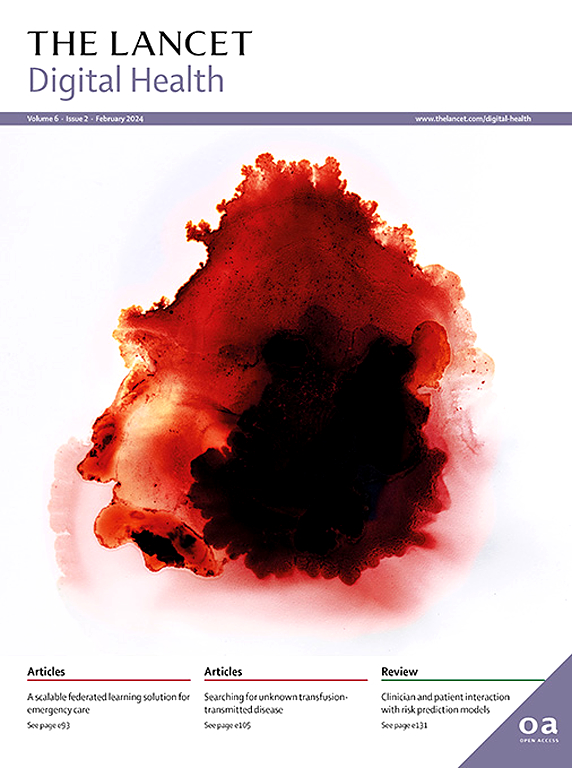人工智能心电图用于死亡率和心血管风险评估:模型开发和验证研究。
IF 23.8
1区 医学
Q1 MEDICAL INFORMATICS
引用次数: 0
摘要
背景:人工智能(AI)支持的心电图(ECG)可用于预测未来疾病和死亡风险,但尚未被临床实践所采用。现有的模型预测不具备个体患者层面的可操作性、可解释性或生物合理性。我们试图通过开发人工智能心电图风险估算器(AIRE)平台来解决以往人工智能心电图方法的这些局限性:AIRE 平台是在一个二级医疗数据集(贝斯以色列女执事医疗中心 [BIDMC])中开发的,该数据集包含来自 189 539 名患者的 1 163 401 张心电图,利用深度学习和离散时间生存模型,通过单张心电图创建患者特异性生存曲线。因此,AIRE 不仅能预测死亡风险,还能预测死亡时间。AIRE 在来自美国、巴西和英国(UK Biobank [UKB])的五个不同的跨国队列中进行了验证,包括志愿者、初级保健患者和二级保健患者:未来的动脉粥样硬化性心血管疾病(0-696,0-694-0-698;0-643,0-624-0-662)和未来的心力衰竭(0-787,0-785-0-789;0-768,0-733-0-802)。通过全表型和全基因组关联研究,我们确定了预测风险增加的候选生物通路,包括心脏结构和功能的变化,以及与心脏结构、生物老化和代谢综合征相关的基因:AIRE 是一个可操作、可解释、生物学上合理的 AI-ECG 风险评估平台,有望在全球广泛的临床环境中用于短期和长期风险评估:资金来源:英国心脏基金会、国家健康与护理研究所和医学研究委员会。本文章由计算机程序翻译,如有差异,请以英文原文为准。
Artificial intelligence-enabled electrocardiogram for mortality and cardiovascular risk estimation: a model development and validation study
Background
Artificial intelligence (AI)-enabled electrocardiography (ECG) can be used to predict risk of future disease and mortality but has not yet been adopted into clinical practice. Existing model predictions do not have actionability at an individual patient level, explainability, or biological plausibi. We sought to address these limitations of previous AI-ECG approaches by developing the AI-ECG risk estimator (AIRE) platform.
Methods
The AIRE platform was developed in a secondary care dataset (Beth Israel Deaconess Medical Center [BIDMC]) of 1 163 401 ECGs from 189 539 patients with deep learning and a discrete-time survival model to create a patient-specific survival curve with a single ECG. Therefore, AIRE predicts not only risk of mortality, but also time-to-mortality. AIRE was validated in five diverse, transnational cohorts from the USA, Brazil, and the UK (UK Biobank [UKB]), including volunteers, primary care patients, and secondary care patients.
Findings
AIRE accurately predicts risk of all-cause mortality (BIDMC C-index 0·775, 95% CI 0·773–0·776; C-indices on external validation datasets 0·638–0·773), future ventricular arrhythmia (BIDMC C-index 0·760, 95% CI 0·756–0·763; UKB C-index 0·719, 95% CI 0·635–0·803), future atherosclerotic cardiovascular disease (0·696, 0·694–0·698; 0·643, 0·624–0·662), and future heart failure (0·787, 0·785–0·789; 0·768, 0·733–0·802). Through phenome-wide and genome-wide association studies, we identified candidate biological pathways for the prediction of increased risk, including changes in cardiac structure and function, and genes associated with cardiac structure, biological ageing, and metabolic syndrome.
Interpretation
AIRE is an actionable, explainable, and biologically plausible AI-ECG risk estimation platform that has the potential for use worldwide across a wide range of clinical contexts for short-term and long-term risk estimation.
Funding
British Heart Foundation, National Institute for Health and Care Research, and Medical Research Council.
求助全文
通过发布文献求助,成功后即可免费获取论文全文。
去求助
来源期刊

Lancet Digital Health
Multiple-
CiteScore
41.20
自引率
1.60%
发文量
232
审稿时长
13 weeks
期刊介绍:
The Lancet Digital Health publishes important, innovative, and practice-changing research on any topic connected with digital technology in clinical medicine, public health, and global health.
The journal’s open access content crosses subject boundaries, building bridges between health professionals and researchers.By bringing together the most important advances in this multidisciplinary field,The Lancet Digital Health is the most prominent publishing venue in digital health.
We publish a range of content types including Articles,Review, Comment, and Correspondence, contributing to promoting digital technologies in health practice worldwide.
 求助内容:
求助内容: 应助结果提醒方式:
应助结果提醒方式:


